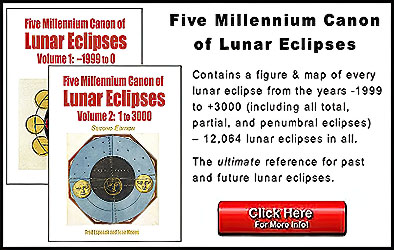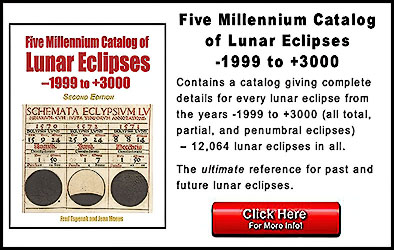The Moon's appearance during a total lunar eclipse can vary enormously from one eclipse to the next. The geometry of the Moon's path through the umbra plays an important role. Not as apparent is the effect that Earth's atmosphere has on eclipses. Although the physical mass of Earth blocks off all direct sunlight from the umbra, the planet's atmosphere refracts some of the Sun's rays into the shadow. Earth's atmosphere contains varying amounts of water (clouds, mist, precipitation) and solid particles (dust, organic debris, volcanic ash). This material filters and attenuates the sunlight before it's refracted into the umbra. For instance, large or frequent volcanic eruptions dumping huge quantities of ash into the atmosphere are often followed by very dark, red eclipses for several years. Extensive cloud cover along Earth's limb also tends to darken the eclipse by blocking sunlight.
In 1921, the French astronomer André-Louis Danjon proposed a useful five point scale for evaluating the visual appearance and brightness of the Moon during total lunar eclipses [L'Astronomie (1921), 35, 261-265]. 'L' values for various luminosities are defined as follows:
| Danjon Scale of Lunar Eclipse Brightness | |
| Danjon Value |
Description |
| L = 0 | Very dark eclipse.
Moon almost invisible, especially at mid-totality. |
| L = 1 | Dark Eclipse, gray or brownish in coloration.
Details distinguishable only with difficulty. |
| L = 2 | Deep red or rust-colored eclipse.
Very dark central shadow, while outer edge of umbra is relatively bright. |
| L = 3 | Brick-red eclipse.
Umbral shadow usually has a bright or yellow rim. |
| L = 4 | Very bright copper-red or orange eclipse.
Umbral shadow has a bluish, very bright rim. |
The amount of light refracted affects the brightness of the moon at mid-eclipse, and this depends on several factors. Volcanic eruptions are one of the most significant factors affecting the brightness of the totally eclipsed Moon. Eruptions that spew large volumes of volcanic ash into the air are generally followed by several years of dark, deep red eclipses. The eruption of Mount Pinatubo in 1991 is notable in that subsequent lunar eclipses were particularly dark. The total lunar eclipse of 1992 Dec 09 was difficult to see with the naked eye and received a Danjon value of L = 0 by many observers.
The assignment of an 'L' value to lunar eclipses is best done with the naked eye near the time of mid-totality. Binoculars or a small telescope may be used, but be sure to note the instrument. It's also useful to examine the Moon's appearance just after the beginning and before the end of totality. The Moon is then near the edge of the shadow and provides an opportunity to assign an 'L' value to the outer umbra.
In making any evaluations, you should record both the instrumentation and the time. Also note any variations in color and brightness in different parts of the umbra, as well as the apparent sharpness of the shadow's edge. Pay attention to the visibility of lunar features within the umbra. Notes and sketches made during the eclipse are invaluable in recalling details, events and impressions.
Observers are encouraged to make Danjon brightness estimates and to report them to Sky and Telescope and to Dr. Richard Keen ([email protected]).
Note: The Moon's Apparent Magnitude During Total Lunar Eclipses is a more objective method of evaluation.




